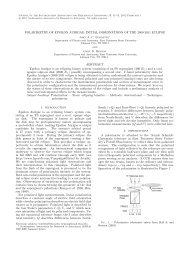Photometry and Lightcurve Analysis of 7 Main-Belt Asteroids - JSARA
Photometry and Lightcurve Analysis of 7 Main-Belt Asteroids - JSARA
Photometry and Lightcurve Analysis of 7 Main-Belt Asteroids - JSARA
You also want an ePaper? Increase the reach of your titles
YUMPU automatically turns print PDFs into web optimized ePapers that Google loves.
42 R. Violante & M. A. LeakeTABLE 1Camera InformationTelescope Camera Gain Readout Noise(e − )SARA North U42 1.2 6.3SARA South QSI 0.46 12.4SARA South Alta E6 1.5 8.9field, cloud coverage during part <strong>of</strong> the run or refocusing<strong>of</strong> the telescope.3. RESULTSA total <strong>of</strong> 7 asteroids were analyzed: 293 Brasilia, 676Melitta, 688 Melanie, 1183 Jutta, 1490 Limpopo, 1677Tycho Brahe, <strong>and</strong> 3156 Ellington. Suggested synodic rotationperiods for three <strong>of</strong> these are proposed <strong>and</strong> summarizedin Table 2. The RMS column refers to the rootmean square dispersion in units <strong>of</strong> 0.01magnitude. Thisunit is the a priori estimated uncertainty (i.e. 1.0 meansthe fit is exactly as good as the estimated noise level(Warner 1999)). Periods for some <strong>of</strong> the other four asteroidswill be discussed but not reported as a result sincethe lightcurves for these were too noisy or not enoughdata was available to make a good estimate.3.1. 676 MelittaFor the determination <strong>of</strong> 676 Melitta’s period, data setsfrom four different UT dates in 2012 were analyzed: June10, 12, 13, <strong>and</strong> 30, at phase angles 7.2, 7.5, 7.7, <strong>and</strong> 11.9degrees, respectively. Exposure times vary from 30 to 60seconds. Clark & Joyce (2003) report a period <strong>of</strong> 7.870± 0.003 hours, which can be found in Behrend (2012),the Observatoire de Genevè lightcurve data base. Ourresults agree with those previously found (See Figure 1).3.2. 688 MelanieFor this asteroid we used data from UT dates July22, 2006, September 21, 2011 <strong>and</strong> October 4, 2011, withphase angles <strong>of</strong> 15.7, 2.3, <strong>and</strong> 8.9 degrees, respectively.Exposures used were 30, 120, <strong>and</strong> 200 seconds. Observationsby Bernasconi in 2005 <strong>and</strong> Roy in 2011 reportedby Behrend (2012) yield a period <strong>of</strong> 19.97 ± 0.41 hours.Stephens (2012) suggests a period <strong>of</strong> 18.87 ± 0.01 hours.Even though we were able to reproduce similar resultsfrom our lightcurve, we found that the RMS values weresmaller for our reported period <strong>of</strong> 16.10 ± 0.05 hours.Another period that also produced small RMS values was14.74 ± 0.05 hours. Aliasing, which is described in thediscussion section, may be an issue in the determination<strong>of</strong> this asteroid’s period (See Figure 2).3.3. 1677 Tycho BraheWe observed 1677 Tycho Brahe on two separate occasions,June 16 <strong>and</strong> July 13, 2012. The phase angles were10.8 <strong>and</strong> 15.3 degrees, respectively. For the final determination<strong>of</strong> Tycho Brahe’s period, we only used the datafrom the July 13 run, giving a result <strong>of</strong> 3.89 ± 0.06 hours.It is relevant to note that 30 second exposures were usedfor the first half <strong>of</strong> the run <strong>and</strong> 120 second exposureswere used for the second half <strong>of</strong> the run, that is why part<strong>of</strong> the plot appears somewhat noisier. The data obtainedon June 16 were extremely noisy <strong>and</strong> doubled the RMS∆m−0.20−0.15−0.10−0.050.000.050.100.15Jun 10 2012Jun 12 2012Jun 13 2012Jun 30 20120.200.0 0.2 0.4 0.6 0.8 1.0PhaseFig. 1.— 676 Melitta, P=8.35 h∆m−0.20−0.15−0.10−0.050.000.050.100.15Jul 22 2011Oct 4 2011Sep 21 20110.200.0 0.2 0.4 0.6 0.8 1.0PhaseFig. 2.— 688 Melanie, P=16.10 h∆m−0.4−0.20.00.20.4Jul 13 20120.0 0.2 0.4 0.6 0.8 1.0PhaseFig. 3.— 1677 Tycho Brahe, P=3.89 hvalues when plotted together with the other data set onMPO Canopus. Considering we followed the target fornearly 5 hours <strong>and</strong>, assuming a bimodal curve, we cancorroborate the period <strong>of</strong> 3.89 ± 0.06 hours from the rawplot <strong>of</strong> magnitude difference versus time. To the best <strong>of</strong>our knowledge, no previous period has been proposed forthis asteroid (Harris et. al 2011)(See Figure 3).3.4. Other asteroids analyzedData for four more asteroids were reduced <strong>and</strong> analyzedfollowing the same process but the final lightcurves



